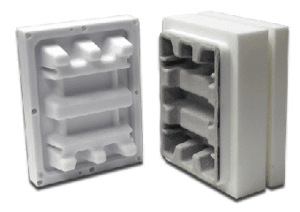Overview
Molded fiber, also known as molded paper pulp, has been used since the 1930s to create containers, trays, and other packages. Today, molded pulp packaging is widely used for electronics, household goods, automotive parts and medical products. These tools are traditionally made by machining a metal tool in the shape of a mirror image of the finished package. Holes are drilled and the vacuum is drawn through them while a screen prevents the pulp from clogging. This process costs about $30,000 and takes two weeks to make a metal tool for a larger package. 3D printing helps eliminate the need for expensive machining and automatically builds the fine holes necessary for effective vacuum draw in paper pulp molds.

Advantage
3D printing with FDM technology is the ideal alternative method for producing molded pulp tooling as it provides dramatic time and cost savings while improving the appearance of the finished product. FDM molded pulp tooling can be produced is cheaper and quicker because it can be made with both porous and rigid properties. This process can run alongside traditional molds with no alternation to cycle time or vacuum pressure, giving manufacturers a seamless integration of FDM tooling to their molding operation.
Process
The geometry of FDM pulp tooling is similar to metal tooling where instead the holes are removed. Designers can easily maximize airflow and minimize clogging by altering raster gaps in the FDM toolpath. FDM materials such as ABS-M30 and Polycarbonate (PC) are recommended molded pulp packaging tooling where PC is ideal for maximum strength and stiffness and ABS when a small degree of flex is fitting.